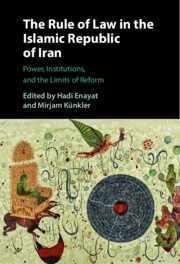Book contents
- The Rule of Law in the Islamic Republic of Iran
- The Rule of Law in the Islamic Republic of Iran
- Copyright page
- Contents
- Figures, Maps and Tables
- Contributors
- Acknowledgments
- Note on Transliteration
- Chronology
- Abbreviations and Glossary
- 1 Governing the Law in the Islamic Republic of Iran
- 2 The Islamic Penal Code of 2013
- 3 The Administration of Criminal Justice in Iran
- 4 Shiʿi Family Law under the Rule of Law? The Iranian Model and Current Approaches in the Shiʿi World
- 5 Rule of Law or Rule by Law? Iran’s Bar Association as a Pawn in Islamic–Republican Contestations
- 6 Law Enforcement and the Judiciary in Postrevolutionary Iran
- 7 The Problem of Overcrowded Prisons in the Islamic Republic of Iran
- 8 Legal Barriers to Accessing Vital Medical Services and Creative Responses to Overcoming These
- 9 Reform from Within? Hākemiyat-e Qānun from the Reformist Era to 2022
- 10 Iran’s Religious and Ethnic Minorities in the Eyes of the Judiciary and the Security Apparatus
- 11 Labor Rights in Postrevolutionary Iran
- 12 The Effects of the Joint Comprehensive Plan of Action (JCPOA), and Subsequent US Withdrawal, on Iranian Law
- 13 Multilayered Mechanisms of Control and Censorship of Arts and Culture in the Islamic Republic of Iran
- 14 The Legal Situation Regarding Assisted Reproduction in Iran
- 15 Conclusions
- Index
- References
10 - Iran’s Religious and Ethnic Minorities in the Eyes of the Judiciary and the Security Apparatus
Published online by Cambridge University Press: 10 April 2025
- The Rule of Law in the Islamic Republic of Iran
- The Rule of Law in the Islamic Republic of Iran
- Copyright page
- Contents
- Figures, Maps and Tables
- Contributors
- Acknowledgments
- Note on Transliteration
- Chronology
- Abbreviations and Glossary
- 1 Governing the Law in the Islamic Republic of Iran
- 2 The Islamic Penal Code of 2013
- 3 The Administration of Criminal Justice in Iran
- 4 Shiʿi Family Law under the Rule of Law? The Iranian Model and Current Approaches in the Shiʿi World
- 5 Rule of Law or Rule by Law? Iran’s Bar Association as a Pawn in Islamic–Republican Contestations
- 6 Law Enforcement and the Judiciary in Postrevolutionary Iran
- 7 The Problem of Overcrowded Prisons in the Islamic Republic of Iran
- 8 Legal Barriers to Accessing Vital Medical Services and Creative Responses to Overcoming These
- 9 Reform from Within? Hākemiyat-e Qānun from the Reformist Era to 2022
- 10 Iran’s Religious and Ethnic Minorities in the Eyes of the Judiciary and the Security Apparatus
- 11 Labor Rights in Postrevolutionary Iran
- 12 The Effects of the Joint Comprehensive Plan of Action (JCPOA), and Subsequent US Withdrawal, on Iranian Law
- 13 Multilayered Mechanisms of Control and Censorship of Arts and Culture in the Islamic Republic of Iran
- 14 The Legal Situation Regarding Assisted Reproduction in Iran
- 15 Conclusions
- Index
- References
Summary
This chapter examines the rights situation of religious and ethnic minorities in the Islamic Republic. All state institutions are in some ways responsible for the Islamic Republic’s discriminatory policies. The intelligence and security apparatus intimidate and arrest members of minority groups, and the judiciary usually issues harsh sentences against them. The executive branch also engages in discriminatory action, such as denying higher education and public sector employment to minorities. The parliament, having passed discriminatory laws, does not hold other state organs responsible for extra-legal actions against minorities. Nor has it conducted investigations necessary to determine the extent of discriminatory practices in the country. Courts have reacted to minority cases in diverse ways, often validating discrimination but in some cases also protecting them against rights abuses. If this diversity in court rulings indicates anything, it is that not all courts are completely on the government’s line but retain some modicum of political independence. The bigger picture is, however, that minority cases are often treated as politically sensitive irrespective of the nature of the case and are therefore tried in the revolutionary rather than the general courts.
Keywords
- Type
- Chapter
- Information
- The Rule of Law in the Islamic Republic of IranPower, Institutions, and the Limits of Reform, pp. 289 - 330Publisher: Cambridge University PressPrint publication year: 2025

